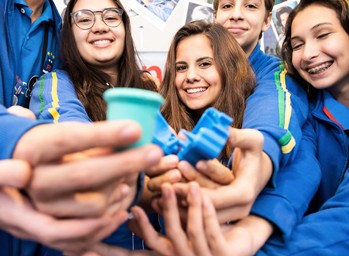
Engineering Education from a Distance
EXPERT OPINION
ACADEMIC AND RESEARCH | 7 MINUTE READ
Remote learning is more critical than ever. So let’s talk with one of the engineering education industry’s remote learning pioneers.
As students return to school, many are heading back to computer screens to receive the bulk of their instruction. Today, remote learning is more critical than ever, but some scholars have been pioneering this format within engineering education for quite some time. One of those pioneers is Professor Timothy D. Drysdale, chair of Technology Enhanced Science Education at the University of Edinburgh. We sat down (virtually) with Professor Drysdale to talk not just about engineering education but remote engineering education.
NI:
You’ve been a pioneer in remote labs for several years now. What initially drove you to remote engineering education?
Professor Drysdale:
The world has been moving in a digital direction for several decades now. For years, it’s been obvious to me that institutes of higher learning around the world were going to need to do more than just understand teaching trends — they were going to have to figure out how to enable effective distance education. This is no longer an option, it’s critical, and in many cases, required.
I have a background in a mixture of subjects that are well matched to remote labs. When an opportunity came up in distance education to take on a remote laboratories project, it was a perfect confluence of factors. Because of this convergence, I was able to move into remote engineering education in a significant and impactful way.

NI:
What has your role been in progressing remote learning in engineering?
Professor Drysdale:
In 2015, when I started on remote labs, I wanted emotional engagement between remote users and the respective equipment. Since then, I’ve been pioneering this concept on a large scale: having many experiments running simultaneously with real-time latency and automatic management, as well as automatic management of the security, so that you can share a session with people as needed. Overall, to keep it progressing, it’s about removing the friction so that it can make the jump into mainstream.
NI:
How have you built and leveraged a remote learning community?
Professor Drysdale:
NI brings together science and engineering educators with vastly different research interests. I’d travel to conferences related to my research, and although there were education sessions there, each one focused on a single discipline. But within the NI educator community, you meet people involved in physics or mechanics and many other subjects; you can share your enthusiasm for digital and online practical work regardless of your teaching expertise.
The connections we’ve made through this cross-discipline community is a powerful thing. It’s put me in touch with many others who have developed remote laboratories.
What I’ve learned is that you’re not going to make a remote lab system for electronics, another one for physics, another one for geosciences and so forth. Instead, you need a core structure in place.
However, in order for that digital infrastructure to work the way you want it to, you need to support many different fields. Given the effort that’s required to be effective, that’s the only way to justify the investment.
NI:
If students can’t go to school physically, are they still receiving the same quality of learning as they would if they were not remote?
Professor Drysdale:
The amount of work traditional campuses are having to do to cope with the COVID-19 pandemic is massive, but with enough creativity, you can enable effective online learning. From a teaching perspective, you can also gain access to new pedagogical benefits.
Pooling everyone’s online experiments will open things up. One example that comes to mind: If I get a question from a student that I can answer with equipment that I don’t happen to have, wouldn’t it be great if I could see if someone else had it and then access it right there in my lecture? That’s what I’m working on now — completely melding online education and face-to-face education.
And the data speaks for itself. Studies have shown that online education — with adequate prep under the right conditions and infrastructure — provides a learning opportunity that rivals a real-world experience.
NI:
Do you think that having a digital experience is also going to better prepare students for their work in the future?
Professor Drysdale:
Without a doubt. I’ve met engineers who design computer chips with people they’ve never physically met. They perform all their duties remotely in different countries. This scenario isn’t uncommon.
There are plenty of instances where equipment is in one place and operated in another. When you’re forced to design and build a system like that and then use it, it makes you think in a different way. Students who get to work with equipment remotely are going to be better prepared mentally for this accelerating phenomenon.
NI:
How quickly do you think schools will be able to adopt effective remote learning?
Professor Drysdale:
It’s a complex situation. There are multiple factors to consider that are unique to different campuses, their staff, their students, their expectations and their previous experience with remote learning.
Beyond the here and now, we must consider what the digital revolution means for higher education and how we should position ourselves in five- or 10-years’ time. When I think back to the traditional university campus, most of the improvements you could expect to make came from getting educators together and having them reflect on their practice - many things that mattered could then be changed by individuals. I think those days are over because now our innovations need digital infrastructure.
Now in order to have those digital infrastructures, you need institutional support to buy or develop and then run them. Moreover, I feel very strongly that educators should work together to produce the tools their sector needs.
These tools will come along if academia supports them, but it’s not necessary for every educator to be a digital pioneer. There are many tasks to take care of, so we need a team approach.
Wouldn’t it be amazing if your location (and the location of equipment) no longer predetermined your contribution on the job or to society? I think it would empower more people to fulfill their potential and make the world a much better place.
Wouldn’t it be amazing if your location (and the location of equipment) no longer predetermined your contribution on the job or to society? I think it would empower more people to fulfill their potential and make the world a much better place.

NI:
What are the important elements you see that we must continue to include in engineering education regardless of the learning format?
Professor Drysdale:
I really like the idea of failing faster so you can get to the right answer quicker. This approach differs markedly from how most students learn at school, where the answer is usually found at the back of a book.
Putting yourself in environments where the answer isn’t as accessible — where you can explore and make mistakes — is incredibly important. There’s an opportunity here to create safe spaces where people feel “free to play” and comfortable taking part in that exploration.
We also need to provide students with the experience of leadership — so they can learn to deal with the consequences of their decisions. You can’t just play all the time. You must learn to take responsibility.
NI:
So, how will remote learning influence STEM education in the future?
Professor Drysdale:
I think remote learning is going to be a great way of connecting everybody around the world. It cultivates practical work experiences that help enhance the lives of people everywhere. And it’s a great way to improve the sustainability of our resources when it comes to producing equipment for education; we can have fewer pieces of equipment, and people can access them remotely.
Wouldn’t it be amazing if your location (and the location of equipment) no longer predetermined your contribution on the job or to society? I think it would empower more people to fulfill their potential and make the world a much better place. It’s magical when you think about it.
NI:
Yes, Professor Drysdale, it sure is. Let’s make it happen together.


